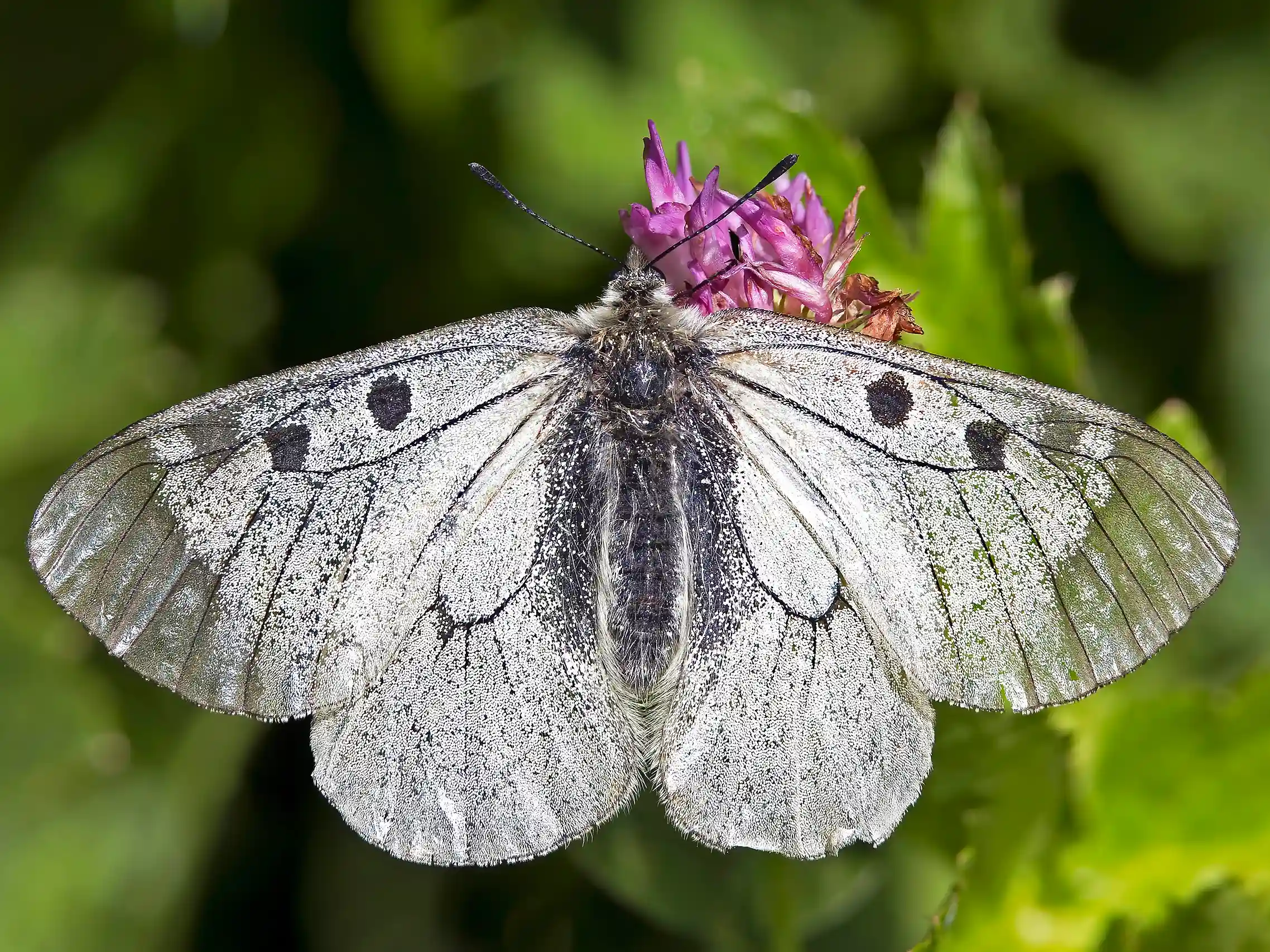Help
This map shows observations of the species Parnassius mnemosyne from the year 2000 onwards.
The blue markers indicate the frequency of the observations, with darker blue regions indicating more observations in that area.
All observations were obtained from Global Biodiversity Information Facility (GBIF)
.
You can visit
the GBIF page on the species Parnassius mnemosyne by clicking here.
Taxonomy
Description
The Clouded Apollo (Parnassius mnemosyne) is a swallowtail butterfly found in a geographical span from western Europe to central Asia (Talla et al., 2023). It has white wings with two black spots on each fore-wing and a wing span of 55–68 mm. It is classified as an endangered species in Sweden since year 2000 (SLU Artdatabanken, 2024). Globally, the population is decreasing, and the species is now mainly found in small, fragmented local populations (Nadler, J. et al., 2021; Westin et al., 2018). Historically, the distribution of the Clouded Apollo was continuous across southern Sweden, but it is today only found in three regions: Blekinge, Roslagen, and Västernorrland (SLU Artdatabanken, 2024). A likely reason for the decline is the loss of suitable habitats due to changes in human agricultural activities. These include meadows and semi-natural grasslands with access to the host plants Corydalis sp. (Johansson et al., 2017).
The genome assembly hosted in the portal was generated in a study by Höglund et al. (2024) as a pilot project of the European Reference Genome Atlas (ERGA). The samples used in the study came from a captive population that was founded as part of a conservation effort by Nordens Ark (Höglund et al., 2024; Nordens Ark, 2024).
How to cite
If you use the data presented in the genome portal from this species in your research, please cite the original publication(s):
Höglund, J., Dias, G., Olsen, R. A., Soares, A., Bunikis, I., Talla, V., & Backström, N. (2024). A Chromosome-Level Genome Assembly and Annotation for the Clouded Apollo Butterfly (Parnassius mnemosyne): A Species of Global Conservation Concern. Genome Biology and Evolution, 16(2), evae031. https://doi.org/10.1093/gbe/evae031If you have used the pages for this species in the Genome Portal, please refer to it in-text as: “The Parnassius mnemosyne entry in the Swedish Reference Genome Portal (Retrieved ).” and use the following for the bibliography:
Swedish Reference Genome Portal (Retrieved ), SciLifeLab Data Centre, version 1.5.3 from https://genomes.scilifelab.se, RRID:SCR_026008References
Johansson, V., Knape, J., & Franzén, M. (2017). Population dynamics and future persistence of the clouded Apollo butterfly in southern Scandinavia: The importance of low intensity grazing and creation of habitat patches. Biological Conservation, 206, 120–131. https://doi.org/10.1016/j.biocon.2016.12.029
Nadler, J., Benyamini, D., Bonelli, S., Comay, O., Dapporto, L., Karaçetin, E., Lukhtanov, V., López Munguira, M., Micevski, N., Settele, J., Tzortzakaki, O., Verovnik, R., Warren, M., Wiemers, M., Wynhoff, I., & van Swaay, C. (2021). Parnassius mnemosyne. The IUCN Red List of Threatened Species. https://dx.doi.org/10.2305/IUCN.UK.2021-1.RLTS.T174210A122602056.en
Nordens Ark. (2024). Clouded Apollo conservation. https://en.nordensark.se/conservation/clouded-apollo/
SLU Artdatabanken. (2024). Artfakta: Parnassius mnemosyne. https://artfakta.se/taxa/101510/information
Talla, V., Mrazek, V., Höglund, J., & Backström, N. (2023). Whole genome re-sequencing uncovers significant population structure and low genetic diversity in the endangered clouded apollo (Parnasssius mnemosyne) in Sweden. Conservation Genetics, 24(3), 305–314. https://doi.org/10.1007/s10592-023-01502-9
Westin, A., Lennartsson, T., & Björklund, J.-O. (2018). The historical ecology approach in species conservation – Identifying suitable habitat management for the endangered clouded Apollo butterfly (Parnassius mnemosyne L.) in Sweden. AIMS Environmental Science, 5(4), 244–272. https://doi.org/10.3934/environsci.2018.4.244
Changelog
- 10/04/2025 - Update links to Artfakta and Nordens Ark
- 04/12/2024 - Mitochondrial assembly and annotation track added to genome browser
- 15/10/2024 - Species first published on the Portal
Page last updated: 22/10/2024

